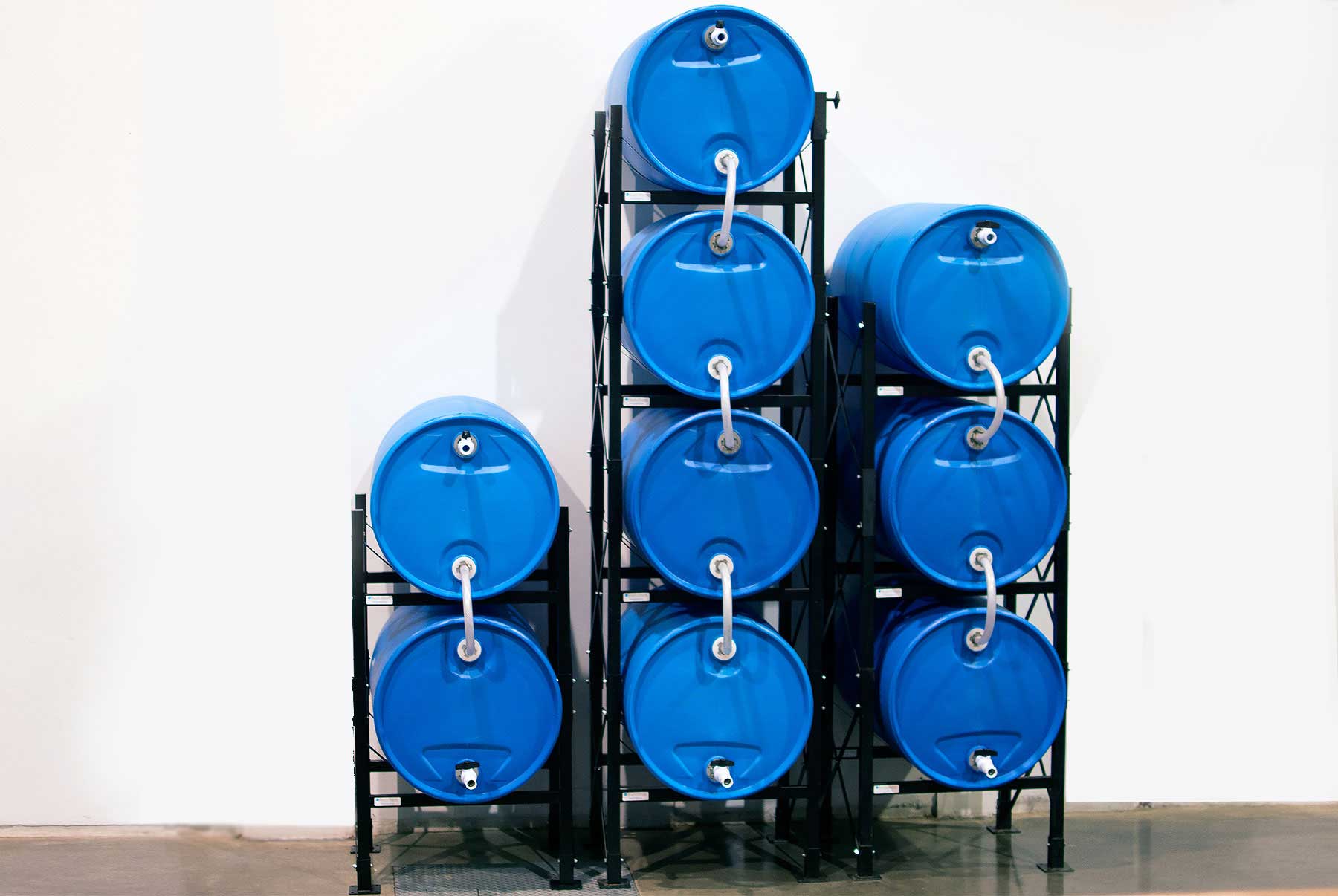Ensuring a reliable supply of fresh water in the event of emergencies is a critical aspect of home preparedness. Water is essential not only for drinking but also for hygiene and cooking; thus, long-term water storage becomes a fundamental part of planning for unforeseen situations. By adopting best practices for storing water over extended periods, you can guarantee that your household maintains access to this vital resource when it's needed most.
The key to effective long-term water storage is understanding your specific water needs, selecting the appropriate containers, and managing the storage environment to preserve water quality. Proper treatment methods play a crucial role in extending the shelf-life of stored water and preventing contamination. Knowing how to do this right ensures safety and accessibility, reducing the stress of potential water scarcity during emergency situations.
Key Takeaways
- Proper long-term water storage ensures access to essential water supplies in emergencies.
- Selecting suitable containers and treatment methods is crucial for maintaining water quality.
- Understanding storage conditions and regular maintenance are key to reliable water storage.
Understanding Water Needs
Understanding your household's daily water needs is critical when planning for long-term storage. You need to ensure an adequate supply for hydration, cooking, and basic hygiene.
Assessing Daily Water Usage
First, calculate your household's daily drinking water needs. An average person needs about half a gallon of water per day just for drinking. Assess the number of people in your home and note down the collective daily requirement. Next, estimate water usage for cooking and hygiene. Cooking may require up to a gallon per day, depending on your diet. Hygiene practices, such as handwashing and teeth brushing, typically use around 2-4 gallons per person each day. Do not forget to account for the needs of your pets, adding approximately one quart per pet.
Calculating Storage Requirements
To compute how much water to store, begin with your daily usage figure and multiply by the number of days for which you aim to prepare. For example, if you've determined your household uses 12 gallons per day and you want a two-week supply, you will need 168 gallons of water. It’s recommended to have at least a two-week supply for emergencies. Use the following table to guide your calculations:
| Household Size | Daily Usage (Gallons) | 2-Week Supply (Gallons) |
|---|---|---|
| 1 person | 3-5 | 42-70 |
| 2 people | 6-10 | 84-140 |
| 4 people | 12-20 | 168-280 |
| 6 people | 18-30 | 252-420 |
Ensure that you also consider additional water for any special needs such as medical conditions or pregnancy.
Choosing Storage Containers
When planning for long-term water storage, selecting the right containers is crucial. You'll need to consider the material and safety features to ensure water remains potable.
Types of Containers
- Glass: Glass containers do not leach chemicals, but they can be heavy and fragile.
- Plastic: Look for food-grade, BPA-free plastic containers, commonly identified by the symbols #1, #2, #4, and #5.
- Stainless Steel: Ideal for durability, but avoid if storing chlorinated water as it can corrode steel.
- Fiberglass: Suitable for large volume storage, though they need a food-grade lining.
Container Safety Standards
- Food-Grade Labeling: Ensure that any container you use is clearly labeled as food-grade.
- NSF Certification: Containers should have NSF/ANSI standard certification, indicating they meet public health and safety standards.
- BPA-Free: Especially with plastic containers, verify they are BPA-free to avoid chemical contamination.
- UV Resistance: For containers that will be exposed to light, ensure they have UV resistance to prevent algae growth.
Water Treatment Methods
In ensuring your water storage remains safe for consumption over time, you'll need to apply specific treatment methods. These are split between purification techniques and the use of chemicals.
Purification Techniques
Boiling: Boil your water for at least one minute at rolling boil to kill most pathogens. At altitudes above 2,000 meters, increase boiling time to three minutes.
Filtration: Use a filter designed to remove bacteria, protozoa, and other contaminants. Filters with a pore size of 0.2 micrometers are recommended.
Ultraviolet Light: UV light purifiers can neutralize bacteria, viruses, and protozoa. Ensure that the water is clear for the UV light to work effectively.
Distillation: By boiling water and then capturing the condensation, you can remove impurities. This is one of the few methods that can remove heavy metals and salts.
Preservation and Treatment Chemicals
Chlorine Bleach: Add unscented bleach (5.25%-8.25% sodium hypochlorite) to your water in the correct ratio; typically, it's about 6 drops per gallon of water. Stir and let it stand for 30 minutes.
Iodine: Iodine tablets can be used as an alternative to bleach, following the manufacturer's instructions regarding the number of tablets per volume of water.
Calcium Hypochlorite: A granular form of chlorine can be used for large volumes of water or can be used to make a chlorine solution for disinfection. It's more stable and has a longer shelf-life than liquid bleach.
Commercial Water Preservers: These are specifically formulated for long-term water storage and can keep water safe for up to 5 years when used as directed.
Remember to always check expiration dates for chemicals and follow the recommended dosages precisely to ensure safety.
Storage Conditions and Environment
When storing water long-term, ensuring the right conditions and environment is crucial for maintaining its quality and safety. Here are the key factors you need to consider.
Temperature Considerations
You should store your water in a cool, consistent environment ideally between 50°F and 70°F (10°C to 21°C). Extreme temperatures can promote algae or bacteria growth and can also degrade your storage containers. If water freezes, it could expand and crack the containers. Make sure your storage area is temperature-controlled or insulated against weather extremes.
Sunlight and UV Exposure
Keep your water storage containers away from direct sunlight, as UV rays can penetrate most plastic containers and lead to degradation of both the container and the water quality. This can cause leaching of harmful chemicals into your water. Store the water in a dark place or use containers that are specifically designed to block out sunlight.
Space Optimization
Maximizing space while ensuring accessibility is important in water storage. Utilize vertical space with sturdy shelving, keeping heavier containers on lower shelves. Always ensure that your water supply is easily reachable in case of an emergency. Here’s an example of how to organize your space for water storage:
-
Shelving Layout:
- Top shelf: Light supplies such as water purification accessories.
- Middle shelves: Moderate-sized containers that can be moved if needed.
- Bottom shelf: Heavy, large-capacity water storage barrels.
-
Accessibility: Maintain clear and unobstructed paths to your water storage.
Maintaining Water Quality
Ensuring the safety and quality of your stored water is critical for your preparedness plans. Regular checks and rotation are key for maintaining potable water.
Regular Quality Checks
You should test your stored water every six months for purity and bacteria. Use a water test kit to check for common contaminants like bacteria, nitrates, and pH levels. If you detect impurities, treat the water with chlorine bleach — usually about eight drops per gallon. After treatment, retest the water to confirm its safety for consumption.
Rotating Stored Water
Every six months to one year, it is essential to rotate your stored water. Empty the containers, clean them with a diluted bleach solution (one teaspoon of unscented bleach per quart of water), and refill them with fresh water. When filling the containers, ensure the water comes from a reliable source and is free of sediments and odors.
Emergency Access and Usage
In a crisis, having prompt access to your water supply and managing it wisely can make all the difference. This section covers practical steps and rationing tactics to maximize your water security during emergencies.
Quick Access Strategies
To ensure quick access to your water reserves:
- Label your containers clearly to avoid confusion and save time.
- Store water in multiple locations to minimize the impact of any single point of access being compromised.
- Use containers like drums with spigots or stackable water bricks, which allow for easy dispensing without the need to move heavy containers.
Rationing in Emergencies
Effective water rationing is crucial:
- Establish a daily per-person water usage limit; 1 gallon per day is typically recommended.
- Itemize water usage by necessity, giving priority to drinking and basic hygiene.
- Keep track of your water consumption with a log sheet, ensuring adherence to rationing plans.
Remember to adjust these strategies based on the number of individuals in your home and the specific demands of any given emergency.
Frequently Asked Questions
In this section, you'll find concise answers to common questions relating to storing water safely and effectively for long-term needs.
What is the ideal type of container for long-term water storage?
The best containers for long-term water storage are made of food-grade plastic or stainless steel and have a tight-fitting, screw-on cap. Ensure they're opaque and colored to limit light exposure, deterring algae growth.
How much bleach is needed to treat water for long-term storage?
For clear water, add eight drops of regular, unscented household bleach (containing 5.25-8.25% sodium hypochlorite) per gallon. If the water is cloudy, double the amount to 16 drops per gallon.
What are effective methods to ensure water freshness during extended storage?
Rotate your stored water every six months and keep it in a cool, dark place to maintain freshness. Use water preservers that are specifically designed for long-term storage, which can extend water life up to five years.
What is the recommended quantity of water to store for emergency preparedness?
Store at least one gallon of water per person per day for drinking and sanitation. Aim for a minimum of a two-week supply for each household member.
For how many years is it safe to store water using proper techniques?
With the proper storage techniques and conditions, water can be safely stored for up to 5 years. However, regular inspection and rotation are essential for maintaining water quality.
What steps are involved in preparing water for long-term storage?
First, clean the containers with soapy water and rinse thoroughly. Sanitize with a solution of one teaspoon bleach per quart of water. Fill the container with treated drinking water and seal it tightly, labeling with the storage date. Store in a cool, dark place away from direct sunlight and harmful chemicals.

